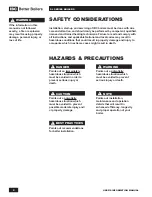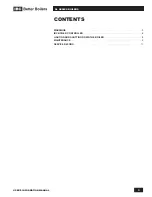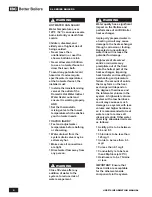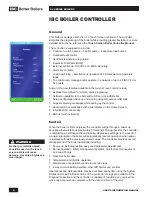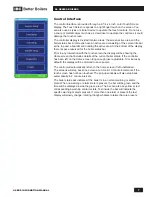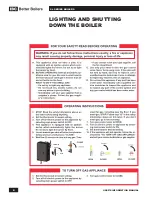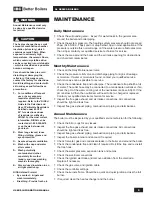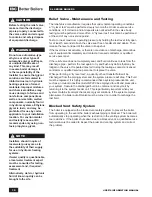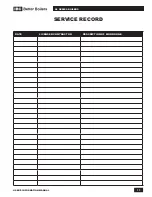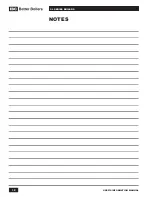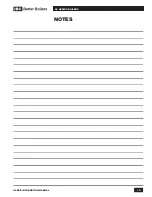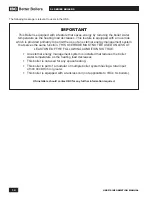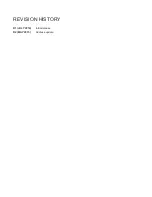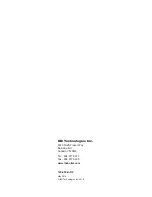
9
USER’S INFORMATION MANUAL
SL SERIES BOILERS
MAINTENANCE
Daily Maintenance
•
Check the surrounding area – inspect for water leaks in the general area
around the boiler and boiler piping
•
Check the system pressure. The heating system pressure should not exceed
25psi (SL 80-399 - 75psi) and not drop below 10psi in most applications. If the
pressure is outside this normal range or if the water pressure fluctuates more
than 2-3psi, contact your qualified service technician for service.
•
Check the area around the boiler and the air intake opening for obstructions
and chemical contaminates.
Monthly Maintenance
•
Check all the Daily Maintenance items.
•
Check the pressure relief valve and discharge piping for signs of leakage
or moisture. If water or moisture is found, contact your qualified service
technician as soon as possible for service.
•
Check the condensate trap and outlet pipe. The condensate trap shall be full
of water. The outlet hose may be connected to a condensate neutralizer, if so,
check the pH of the water coming out of the neutralizer is above 6.0pH. If the
pH is below 6.0 then the neutralizer will need to be re-charged or replaced.
Contact your qualified service technician for service.
•
Inspect the flue gas exhaust and air intake connections. All connections
should be tight and leak free.
•
Inspect flue gas exhaust piping, combustion air piping and terminations.
Annual Maintenance
The boiler must be inspected by your qualified service technician for the following:
•
Check the Error Logs for any issues.
•
Inspect the flue gas exhaust and air intake connections. All connections
should be tight and leak free.
•
Inspect flue gas exhaust piping, combustion air piping and terminations.
•
Inspect the boilers interior and vacuum if required.
•
Check for water, gas and condensate leaks in the boiler and around the boiler.
•
Check the condensate trap and clean if required. Re-fill the trap and re-install
the trap hook.
•
Check the water pressure, expansion tank and pumps.
•
Check the electrical connections.
•
Check the ignition electrode and remove oxidation from the electrode.
Replace if necessary.
•
Check the gas valve and ignition cable.
•
Check the controller settings.
•
Check the burners flame. Should be a quick and quiet ignition across the full
burner.
•
If required, clean the heat exchanger and the burner.
WARNING
Annual Maintenance must only
be done by a qualified service
technician.
CAUTION
The heat exchanger has a small
amount of combustion chamber
insulation (refractory), which
contains ceramic fibers. When
exposed to extremely high
temperatures, the ceramic fibers,
which contain crystalline silica,
can be converted into cristobalite
- which is classified as a possible
human carcinogen.
Care should be taken to avoid
disturbing or damaging the
refractory. If damage occurs,
contact the factory for directions.
Avoid breathing and contact with
skin and eyes and follow these
precautions:
1.
For conditions of frequent
use or heavy exposure,
respirator protection is
required. Refer to the “NIOSH
Guide to the Selection and
Use of Particulate Respirators
Certified under 42 CFR
84” for selection and use
of respirators certified by
NIOSH. For the most current
information, NIOSH can be
contacted at 1-800-356-4676
or on the web at www.cdc.
gov/niosh.
2.
Wear long sleeved, loose
fitting clothing, gloves and
eyes protection.
3.
Assure adequate ventilation.
4.
Wash with soap and water
after contact.
5.
Wash potentially
contaminated clothes
separately from other
laundry and rinse washing
machine thoroughly.
6.
Discard used insulation in an
air tight plastic bag.
NIOSH stated first aid:
•
Eye contact - Irrigate and
wash immediately.
•
Breathing - Provide fresh air.


